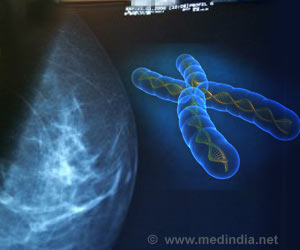Learn about the BRCA1 gene, pleomorphic carcinoma in situ, breast cancer risk and current treatment recommendations.

Jolie’s case is noteworthy because she never actually had cancer but she underwent two major surgeries in order to reduce her risk for breast cancer and ovarian cancer. She inherited a mutated BRCA1 gene, a tumor suppressor normally responsible for repairing damaged DNA. When a harmful BRCA1 mutation is inherited, a woman’s risk of developing breast cancer is increased by 5 fold and the risk for ovarian cancer is increased by nearly 40 fold. Her decision to prophylactically reduce her cancer risk seems radical to some, but many physicians and scientists recommend this as a valid treatment option. She is arguably quite fortunate to have access to the resources to determine her genetic susceptibility to these cancers and to greatly reduce her risk of dying at a young age by undergoing surgery.
Her other option would have been to undergo rigorous screening for breast and ovarian cancer at frequent intervals as recommended by her doctors. This is also not an unreasonable option, but early ovarian cancer is difficult to detect, hence Jolie’s decision to have her ovaries surgically removed. Note that prophylactic mastectomy does not completely eliminate one’s risk for breast cancer, as complete removal of all breast tissue (on a microscopic level) cannot be guaranteed, but preliminary evidence suggests that prophylactic bilateral mastectomy reduces one’s breast cancer risk to that of the general population.
Wilson’s case is different from Jolie’s in that her cancer risk was increased not by a BRCA1 mutation, but the presence of a premalignant condition termed pleomorphic carcinoma in situ (PLCIS). Because of Wilson’s strong family history for breast cancer, she started aggressive breast cancer surveillance (mammography, physical exam and breast biopsies) at an early age. When PLCIS was discovered on biopsy, her doctors increased the intensity of her screening because PLCIS—a benign, or premalignant condition—is associated with a concomitant malignancy in 49% of cases. Indeed, Wilson was found to have a microscopic focus of invasive cancer on her most recent biopsy so she elected to have a bilateral mastectomy in order to both remove the cancer and decrease her risk for future disease.
Although BRCA1 mutations and PLCIS are rare in the general population, Jolie’s and Wilson’s open discussion about their health issues have greatly increased breast cancer (and ovarian cancer) awareness among the public. These brave women are on the forefront of medical science and current clinical decision making since it has only been relatively recently that most cancer predisposing genes (such as BRCA1) have been identified. Medical and surgical treatment guidelines are still in evolution, especially in the case of PLCIS, but clear epidemiological evidence of cancer risk and cancer recurrence risk strongly argue for prophylactic surgery as a standard of care option.















